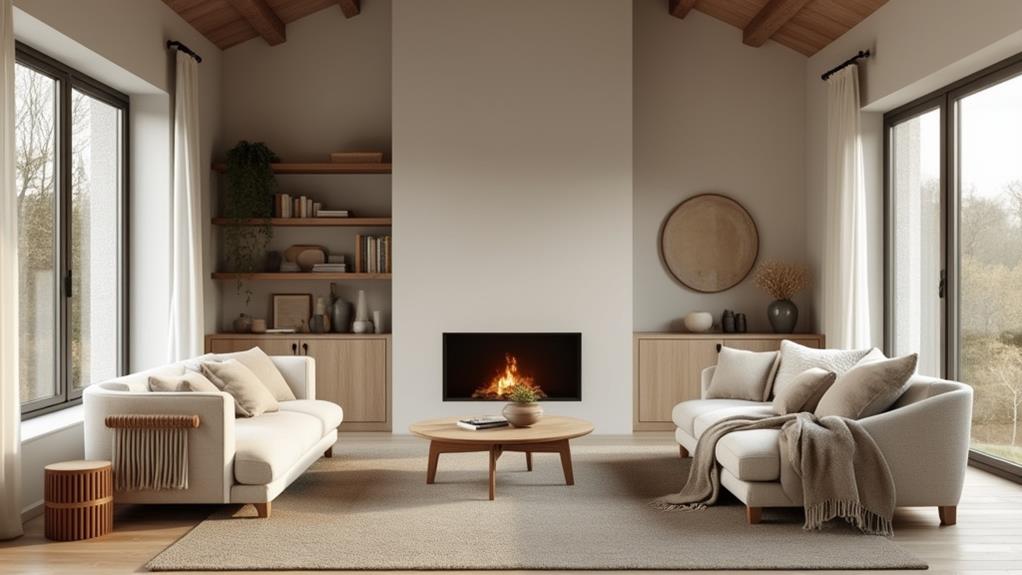To embrace Scandinavian design for cozy living, start by emphasizing simplicity and functionality in your space. Use light wood tones like oak and birch to enhance warmth and brightness, incorporating natural textures such as stone and textiles for depth. Choose neutral color palettes, including whites, grays, and beiges, to create a serene backdrop that amplifies natural light and fosters tranquility. Prioritize maximizing natural light with large windows and mirror placement. Integrate greenery and plants to add organic touches. Opt for multifunctional furniture and guarantee thoughtful space planning for efficiency. By focusing on these elements, you can create a harmonious retreat.
Principles of Scandinavian Design
Scandinavian design often embodies simplicity and minimalism to foster a serene and clutter-free environment.
You'll notice that every piece in a Scandinavian space serves a clear purpose, eliminating unnecessary frills. This approach maximizes usability, ensuring your home remains organized.
Functional design enhances usability while maintaining a sleek aesthetic, focusing on clean lines and neutral color palettes. These elements contribute to a modern look that's both timeless and adaptable.
The integration of natural textures, such as wood and stone, adds depth to the design, promoting relaxation and well-being.
Thoughtful space planning is essential, allowing for smooth movement and functionality.
Light Wood Tones and Textures
One of the key elements in creating a cozy and inviting space is the incorporation of light wood tones and natural textures. When you use light wood, like oak or birch, it naturally enhances the warmth of a room, reflecting and amplifying natural light to make the space feel brighter and more spacious.
Incorporating materials like stone alongside textiles such as cotton, linen, and wool adds depth and tactile appeal, enriching the overall ambiance. Accessories like plants and rattan introduce organic touches, providing a revitalizing and earthy feel.
Furniture pieces, such as dining tables and bookshelves crafted from light wood, can serve as focal points, ensuring both functionality and aesthetic appeal. By integrating these elements, you create a harmonious, inviting environment.
Neutral Color Palettes
Neutral color palettes play an essential role in achieving a serene and timeless backdrop for any space. By incorporating shades like whites, grays, and beiges, you create a versatile base that promotes harmony and balance.
These colors have a calming effect, fostering a tranquil environment ideal for relaxation. Neutral tones aren't only aesthetically pleasing but also functional, allowing you to personalize your space with various accessories and textures.
They guarantee cohesive design elements throughout, making it easier to maintain a sleek and modern look. Additionally, neutral colors reflect and amplify light, enhancing the sense of spaciousness.
This approach supports the Scandinavian emphasis on simplicity and minimalism, assuring your space remains organized and clutter-free.
Maximizing Natural Light
To truly embrace the essence of Scandinavian design, you should often focus on maximizing natural light within your living spaces.
Start by installing large windows, which flood rooms with sunlight, enhancing the overall brightness. Opt for light-colored walls, as they reflect natural light and create an airy atmosphere.
Consider an open layout to facilitate light flow throughout your environment, ensuring every corner benefits from daylight. Strategically place mirrors opposite windows; this amplifies natural light and makes spaces feel larger.
Additionally, arrange furniture away from windows to avoid blocking light entry.
These strategies not only enhance the aesthetic appeal but also contribute to a functional and relaxing space, embodying the principles of Scandinavian design that prioritize simplicity and functionality.
Creating a Cozy Atmosphere
While maximizing natural light creates a bright and airy environment, creating a cozy atmosphere complements this by infusing warmth and comfort into your space.
You achieve coziness by incorporating natural textures, such as wood and stone, which contribute to a warm and inviting environment.
Soft lighting, like lamps and candles, enhances comfort by providing a gentle glow.
Layering textiles, including throws and cushions, adds warmth and coziness, promoting a relaxing ambiance.
Incorporating greenery and plants brings life into the space, adding a natural element that's both soothing and visually pleasing.
Thoughtful color palettes, using neutrals and soft tones, create a soothing ambiance.
Functional and Simple Spaces
Achieving functional and simple spaces in Scandinavian design revolves around prioritizing practicality without sacrificing style.
You focus on clean lines and neutral color palettes to create a sleek, modern look that remains clutter-free. Every piece of furniture serves a purpose, eliminating unnecessary frills and maximizing usability. This approach guarantees spaces are organized, promoting movement and functionality.
Thoughtful space planning allows for efficient use of available areas, making even small spaces feel open and airy. By choosing multifunctional furniture, like a sofa bed or extendable dining table, you enhance usability and adaptability.
Storage solutions, such as built-in shelving or minimalist cabinets, help maintain order. This functional simplicity fosters a calm, inviting atmosphere that's both practical and aesthetically pleasing.
Integrating Nature and Greenery
In Scandinavian design, after establishing functional and simple spaces, incorporating nature and greenery becomes a delightful extension that enhances the overall ambiance.
By integrating natural elements, you not only create a visually pleasing environment but also promote well-being and relaxation.
Plants and greenery introduce organic textures and colors that complement the minimalist style, adding warmth and life.
Natural elements, such as wood and stone, provide a grounding effect.
- Select diverse plant sizes: Consider a mix of small potted plants and larger statement pieces.
- Utilize natural light: Position plants near windows to maximize light exposure and growth.
- Incorporate natural materials: Use wooden planters or stone vases to blend with the décor.
- Rotate plants seasonally: Keep your space dynamic and fresh by changing greenery throughout the year.


